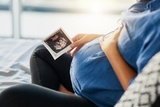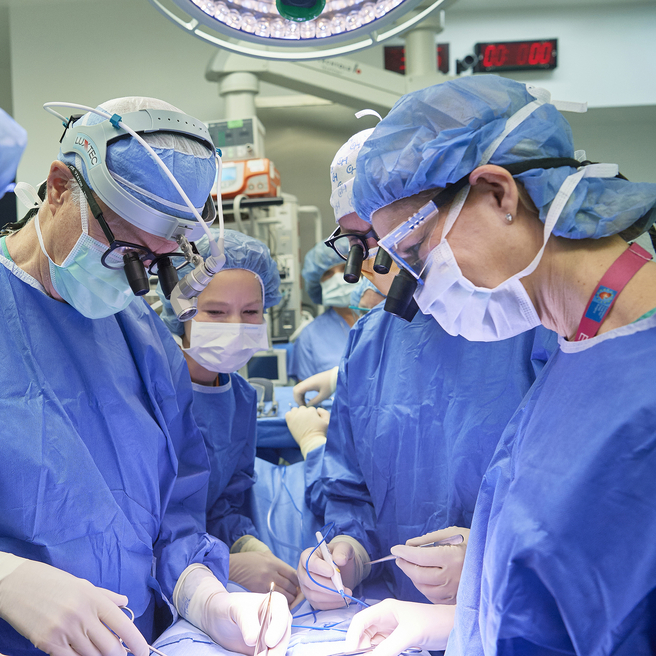What is twin reversed arterial perfusion sequence (TRAP sequence)?
Twin reversed arterial perfusion sequence (TRAP sequence) is a condition that occurs only in twins that share a placenta (monochorionic). One twin, called the parabiotic twin, lacks a functioning cardiac system and receives blood from the normally developing twin, often referred to as the “pump twin.” Because one heart is pumping blood for both twins, the condition places an enormous demand on the heart, putting the pump twin at risk for cardiac failure.
If TRAP sequence is left untreated, the pump twin will not survive in 50 percent to 75 percent of cases due to heart failure. As the non-viable and abnormally developing twin grows larger, the risk to the pump twin rises.
TRAP sequence can also be associated with excess amniotic fluid, caused by increased blood flow to the kidneys that results in overproduction of fetal urine (the primary source of amniotic fluid). This buildup of fluid may cause polyhydramnios, placing the pregnancy at risk for premature rupture of membranes and preterm labor.
“Reversed arterial perfusion” is used to describe this condition because blood flow is opposite from the normal blood supply of the fetus. In TRAP sequence, blood enters the abnormal twin through the umbilical artery, which usually carries blood away from the fetus and back to the placenta. The blood then exits through the umbilical vein, which normally carries blood from the placenta to the fetus.
TRAP sequence affects approximately 1 percent of monochorionic pregnancies, with an incidence of 1 in 35,000 births.
Causes of TRAP sequence
TRAP sequence is a rare complication of twins that share a placenta. Although the exact cause is unclear, TRAP sequence is thought to result from abnormal communication between the blood vessels in the fetal circulation of both twins.
The condition does not appear to run in families and there are currently no reports of recurrence in the same family.
Evaluation and diagnosis of TRAP sequence
Because of the potential strain on the pump twin's heart, cases of TRAP sequence should be evaluated by fetal echocardiography, a specialized ultrasound that provides a detailed view of the fetal heart’s structure and function. The reversed arterial flow in the parabiotic twin should also be documented using color flow Doppler ultrasound.
The difference in fetal weight between the twins is an important factor in predicting the outcome. If the parabiotic twin weighs more than 75 percent of the pump twin size, death of the pump twin occurs in 95 percent of cases.
The risk of further complication to the pregnancy is related to the size of the parabiotic twin. More than half of pregnancies affected by TRAP sequence are complicated by polyhydramnios, and 75 percent experience preterm labor.
If you are referred to CHOP’s Robert D. Wood Jr. Center for Fetal Diagnosis and Treatment, you will be scheduled for a comprehensive one-day evaluation. During this first visit, you will meet with multiple team members, including a genetic counselor, nurse coordinator and maternal-fetal medicine specialist. You’ll also meet with a research coordinator to discuss ongoing research studies. Your evaluation will include a variety of diagnostic tests, including a high-resolution fetal ultrasound, fetal echocardiogram and possibly genetic amniocentesis.
Your test results and specific treatment options will be discussed in detail on the day of your evaluation. If fetal intervention is recommended, you can expect to meet with an advanced practice nurse to complete preoperative testing and a social worker to arrange temporary accommodations in the Philadelphia area. Our team is here to help and support you and your family throughout this experience.
Treatment for TRAP sequence
TRAP sequence is typically treated using a minimally invasive fetal surgery. The goal of fetal surgery is to interrupt the blood supply from the pump twin to the nonviable twin. This reduces the strain on the pump twin’s heart and increases his or her chance of survival.
Treatment for TRAP sequence depends on how many amniotic sacs are present. In twin pregnancies with a shared placenta and two amniotic sacs (monochorionic, diamniotic), treatment involves closing up or blocking off the umbilical cord (occlusion) to the nonviable fetus using a needle device and radiofrequency energy (radiofrequency ablation). In pregnancies with a shared placenta and one amniotic sac (monochorionic, monoamniotic), the cord needs to be closed up and divided due to the risk of cord entanglement. These pregnancies are managed with fetoscopy and bipolar cord coagulation with transection.
Learn more about possible treatment options:
After discharge from our Center’s care, we generally arrange a follow-up ultrasound in one week, after which you may return to your referring doctor for ongoing care and delivery.
Volumes and outcomes
Our team at the Center for Fetal Diagnosis and Treatment cares for a high volume of monochorionic twin pregnancies each year. Since 1995, more than 4,745 complicated multiple gestation pregnancies have been referred to the Center for Fetal Diagnosis and Treatment, including 292 referrals for TRAP sequence.
This experience helps to continuously expand our understanding of these complex pregnancies and our ability to differentiate between conditions such as TRAP sequence, selective intrauterine growth restriction (sIUGR or sFGR), twin anemia polycythemia sequence (TAPS), and twin-twin transfusion syndrome (TTTS).
Reference: Oliver ER, Coleman BG, Goff DA, Horii SC, Howell LJ, Rychik J, Bebbington MW, Johnson MP. Twin reversed arterial perfusion sequence: a new method of parabiotic twin mass estimation correlated with pump twin compromise. J Ultrasound Med. 2013 Dec;32(12):2115-23.

Tour our Fetal Center
The Wood Center for Fetal Diagnosis and Treatment has cared for many families and will help you through your journey, too.

What to expect
From the moment of referral through delivery and postnatal care, your family can expect a supportive experience when you come to us with a diagnosis of a birth defect.
Resources to help
Twin Reversed Arterial Perfusion Sequence (TRAP Sequence) Resources
Richard D. Wood Jr. Center for Fetal Diagnosis and Treatment Resources
Learning your baby has a birth defect is a life-changing experience. We want you to know that you are not alone. To help you find answers to your questions, we've created this list of educational health resources.

